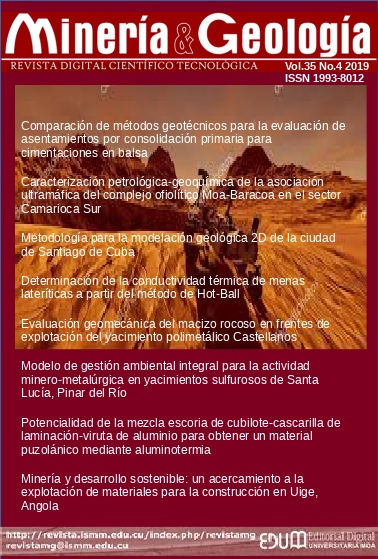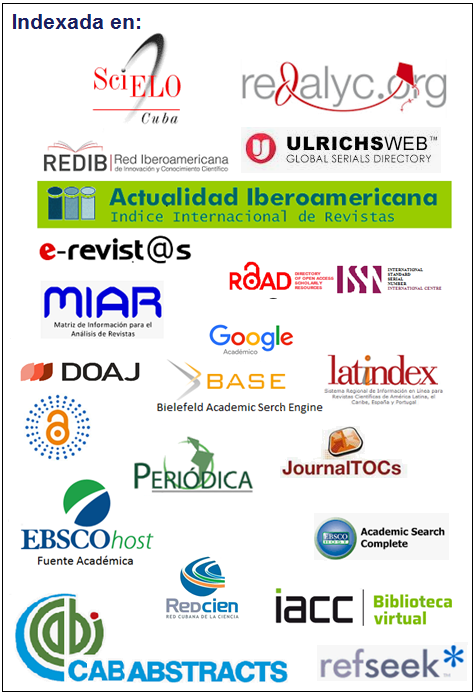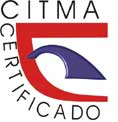Potential of mixing aluminum shavings- cupola slag-mill scale to obtain a pozzolanic material by aluminothermy
Keywords:
cupola slag, aluminothermy process, electric arc, pozzolanAbstract
Chemical and thermodynamic possibilities assessment of aluminum thermodynamic lamination process mill scale-aluminum shavings was made to modify the cupola slag in a pozzolan (SiO2: 70%, Al2O3: 23% and CaO: 7%) by electric arc, using limestone and silica sand. A reaction mixture was designed starting from 100 grams of cupola slag and maintaining the SiO2: Al2O3: CaO ratio equal to 10: 3.29: 1. The mass and energy balances are strategic premises to form the reactive mixture and calculating synthesis time. Aluminothermy reaction provides the necessary alumina content and 46% of energy needed for pozzolan synthesis. The arc energy supply is 11195.87 J / g and gets a total reduction of the intermediate products of aluminothermy reaction. The oxide content of ternary system in synthesized pozzolan increased 23.53% respect to the cupola slag. The rest oxides of chemical composition are reduced 2.86 times from the cupola slag to the synthesized pozzolanic material.Downloads
References
Alujas, A. 2010: Obtención de un material puzolánico de alta reactividad a partir de la activación térmica de una fracción arcillosa multicomponente. Tesis doctoral. Universidad Central Marta Abreu de Las Villas.
American Foundrymen´S Society 1977: El horno de cubilote y su operación. 6ta ed. México: Editorial Continental. 763 p.
Arangurent, F. y Mallol, A. 1963: Siderugía. Madrid: Editorial Dorssat S. A. 617 p.
ASTM C618-03 2003: Standard Specification for Coal Fly Ash and Raw or Calcined Natural Pozzolan for Use as a Mineral Admixture in Concrete. United State.
Baricová, D.; Pribulová, A. y Demeter, P. 2010: Comparison of possibilities the blast furnace and cupola slag utilization by concrete production. Archives of Foundry Engineering, 10(2): 15-18.
Batic, O. R.; Sota, J. D. y Falcone, D. D. 2006: Influencia de la incorporación de escorias en las características de los cementos resultantes. En: Reciclado de residuos de construcción y demolición y de residuos de procesos. Universidad Tecnológica Nacional, San Rafael, Mendoza. ISBN 950-42-0056-7.
Flatt, R. J.; Roussel, N. y Cheeseman, C. R. 2012: Concrete: An eco material that needs to be improved. Journal of the European Ceramic Society, 32(11): 2787-2798.
García, H. R. 2013: SUPERCEM. Experiencia de Holcim (España) con cementos con escorias de alto horno altamente adicionados. Patología de cimentaciones, estructuras y hormigones 1-7.
Hernández, R. A. C.; Durán, D. M. F. y Bustos, L. P. 2014: Reemplazo del agregado fino por escoria de horno de cubilote para la fabricación de concreto. Revista INGE CUC, 10(1): 83-88.
Jerez, P. R.; Rodríguez, L. y Quintana, R. 2002: Caracterización química y mineralógica de residuales sólidos industriales y sus potencialidades de aprovechamiento en la obtención de fundentes aglomerados para el proceso SAW. Rev. Ciencias Técnicas Agropecuarias, 11(2): 59-63.
Kudrin, V. A. 1984: Metalurgia del acero. Moscú: Mir. 423 p.
López, F. A.; López, A. y Balcázar, N. 1996: Propiedades físico químicas y mineralógicas de las escorias EAD y AOD. Revista Afinidad, Tomo LIII: 39-46.
Merzhanov, A. G. y Borovinskaya, I. P. 2008: Historical Retrospective of SHS: Autoreviw. International Journal of Self-Propagating High-Temperature Synthesis, 17(4): 242-265.
Mostafa, N. Y. y Brown, P. W. 2005: Heat of hydration of high reactive pozzolans in blended cements: Isothermal conduction calorimetry. Thermochimica Acta, 435(2): 162-167
Muller, N. y Harnisch, J. 2008: A blueprint for a climate friendly cement industry. WWF. Lafarge Conservation Partnership. Switzerland. Consulta: 13/06/2018. Disponible en: https://www.panda.org/climatesavers.
Patil, K. C. 1993: Advances ceramics: Combustion synthesis and properties. Bulletin of Materials Science, 16(6), 533-541.
Perdomo, L. 2015: Obtención simultánea de ferromanganeso y materiales abrasivos por reducción aluminotérmica usando pirolusita sin tostación previa y residuos sólidos industriales. Minería y Geología, 31(2): 95-112.
Pérez, L. L. 2018: Caracterización química y fásica de un material puzolánico obtenido mediante la modificación de una escoria de cubilote. Tesis de maestría. Universidad Central Marta Abreu de Las Villas.
Perry, R. y Green, D. 2008: Perry´s Chemical Engineers´ Handbook. 8th Ed. New York: McGraw-Hill. ISBN: 9780071422949.
Polder, R. B. 2012: Effects of slag and fly ash on reinforcement corrosion in concrete in chloride environment. Heron, 57(3): 197-210.
Puertas, F. 1993: Escorias de alto horno: composición y comportamiento hidraúlico. Materiales de Construcción, 43(229): 37-48.
Quintana-Puchol, R.; González, L. P.; Apolinaire, E. C.; Cruz, A. L. L.; Varela, E. G. y Gómez, A. D. 2018: Consideraciones sobre las posibilidades de los procesos de síntesis autosostenibles de alta temperatura como una estrategia de reciclaje de desechos sólidos industriales. En: 3ra Convención Internacional de la Industria Cubana Cubaindustria. 19-22 Junio, Palacio de las Convenciones, La Habana, Cuba.
Ramachandran, V. S. y Beaudoin, J. J. 2001: Handbook of analytical techniques in concrete science and technology. Principles, Techniques and Applications. New York, U.S.A.: William Andrew Publishing.
Reuter, M.; Xiao, Y. y Boin, U. 2004: Recycling and environmental issues of metallurgical slags and salt fluxes. In: Delft University of Technology, D. O. A. E. S., Netherlands (ed.) VII International Conference on Molten Slags Fluxes and Salts The South African Institute of Mining and Metallurgy.
Riss, A. 1975: Production of ferroalloys. Moscow: Editorial Foreign languages publishing house. 278 p.
Sánchez, R.; Palacios, M. y Puertas, F. 2011: Cementos petroleros con adición de escoria de horno alto. Características y propiedades. Materiales de Construcción, 302: 185-211.
Singh, S.; Singh, G.; Kulkarni, N.; Mathe, V. L. y Bhoraskar, S. V. 2015: Synthesis, characterization and catalytic activity of Al/Fe2O3 nanotermite. Journal of Thermal Analysis and Calorimetry, 119(1): 309-317.
Taylor, H. F. W. 1990: Cement Chemistry. London: Harcourt Brace Jovanovich.
United States Geological Survey. 2017: Mineral Commodity Summaries [en línea]. Consulta: 21/03/2018. Disponible en: https://minerals.usgs.gov/minerals/pubs/mcs/2017/mcs2017.pdf.
Varma, A.; Rogachev, A. S.; Mukasyan, A. S. y Hwang, S. 1998: Combustion Synthesis of Advanced Materials: Principles and Applications. Advances in Chemical Engineering, 24: 79-226.
Vizcaíno, L. M. 2014: Cemento de bajo carbono a partir del sistema cementicio ternario clínquer-arcilla calcinada-caliza. Tesis doctoral. Universidad Central Marta Abreu de Las Villas.
Published
How to Cite
Issue
Section
- Authors retain copyright and guaranteeing the right magazine to be the first publication of the work as licensed under a Creative Commons Attribution-NonCommercial that allows others to share the work with an acknowledgment of the work's authorship and initial publication in this journal.
- Authors may establish separate supplemental agreements for the exclusive distribution version of the work published in the journal (eg, place it in an institutional repository or publish it in a book), with an acknowledgment of its initial publication in this journal.
- Authors are allowed and recommended to disseminate their work through the Internet (e.g., in institutional telematic archives or on their websites) before and during the submission process, which can produce interesting exchanges and increase citations of the published work. (See The effect of open access)




